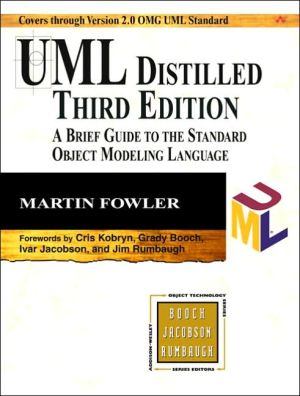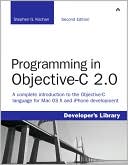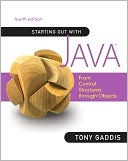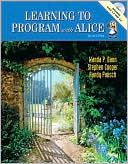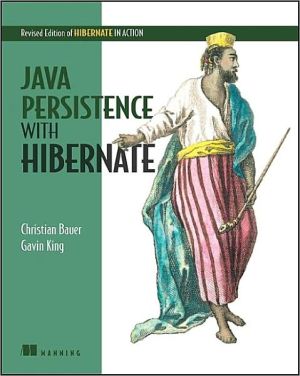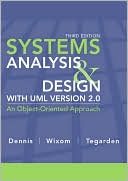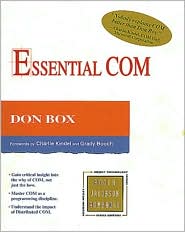UML Distilled: A Brief Guide to the Standard Object Modeling Language, 3rd Edition
Now widely adopted as the de facto industry standard and sanctioned by the Object Management Group, the Unified Modeling Language (UML) is a notation all software developers need to know and understand. However, the UML is a big language, and not all of it is equally important. The award-winning first edition of UML Distilled was widely praised for being a concise guide to the core parts of the UML and has proved extremely successful in helping developers get up and running quickly. UML...
Search in google:
Now widely adopted as the de facto industry standard and sanctioned by the Object Management Group, the Unified Modeling Language (UML) is a notation all software developers need to know and understand. However, the UML is a big language, and not all of it is equally important. The award-winning first edition of UML Distilled was widely praised for being a concise guide to the core parts of the UML and has proved extremely successful in helping developers get up and running quickly. UML Distilled, Second Edition, maintains the concise format with significantly updated coverage of use cases and activity diagrams, and expanded coverage of collaborations. It also includes a new appendix detailing the changes between UML versions. Written for those with a basic understanding of object-oriented analysis and design, this book begins with a summary of UML's history, development, and rationale and then moves into a discussion of how the UML can be integrated into the object-oriented development process. The primary author profiles the various modeling techniques in the UML--such as use cases, class diagrams, and interaction diagrams--and describes the notation and semantics clearly and succinctly. He also outlines useful non-UML techniques such as CRC cards and patterns. These descriptions are made even more relevant with a collection of best practices based on the primary author's experience and a brief Java programming example demonstrating the implementation of a UML-based design. With this tour of the key parts of the UML, readers will be left with a firm foundation upon which to build models and develop further knowledge of the Unified Modeling Language. Praise for the First Edition "UML Distilled is a recipient of the prestigious 1997 Software Development Magazine Productivity Award in the Books category. Addison-Wesley congratulates authors Martin Fowler and Kendall Scott for their outstanding work." "This book is a godsend. It is packed with solid advice presented in a concise and highly readable way. The essence of the notations is explained very well indeed but the author goes beyond this to give very clear insights into the application of UML techniques." —Jennifer Stapleton, Vice President Technical, British Computer Society "UML Distilled is well written, knowledgeable about both systems development and UML, and disarmingly honest." —Robert L. Glass, The Software Practitioner (March 1998) "UML Distilled proves that you can say a lot of useful things about computing in a small book." —Gregory V. Wilson, Dr. Dobb's Journal Booknews A pioneer in the field provides software developer users of this industry standard with a foundation for integrating the Unified Modeling Language into the object-oriented development process, in the context of its history. Appends modeling techniques and their uses, and changes between UML versions. Annotation c. Book News, Inc., Portland, OR (booknews.com)
Two years ago, Addison-Wesley approached me to write a book about the then-new UML. At that time, there was a lot of interest in the UML, but only a standards document from which to learn about it. We broke many records to quickly produce a short introductory guide to the new UML, something that would provide some guidance until the more detailed and official books were to appear later that year. \ \ We didn't expect this book to last after more detailed books appeared. Most people believed that given the choice between a slim overview and a detailed text, everyone would pick the detailed text. Although that was the general view, I believed that even in the presence of detailed books, there was still room for a concise summary. \ \ Two years later, my hopes have been realized more than I could have wished. UML Distilled has been, in computer industry terms, a best-seller. Even though good detailed books have appeared on the UML, the book still sells well. Better than that, more slim books have appeared, confirming my belief that in a world with so much information, there is value in well-chosen brevity. \ \ Now, that's all very well, but should you buy this book? \ \ I'm going to assume you've heard about the UML. It has become the standard way to draw diagrams of object-oriented designs, and it has also spread into non-OO fields. The major pre-UML methods have all died out. The UML has arrived and is here to stay. \ \ If you want to learn about the UML, this book is one way to do it. The main reason for starting with this book is that it's a small book. Buying a big book will give you more information, but it will also take you longer to read. I've selected the most important parts of the UML so that you don't have to. With this book, you'll pick up the key elements of the notation and what they mean. If you want to move further, you can move to a more detailed book later.\ \ If you want a longer tutorial to the UML, I suggest the Unified Modeling Language User Guide (Booch, Rumbaugh, and Jacobson 1999). The User Guide is able to cover a lot more ground. It's well written and organized in a way that explains how to apply the UML to various modeling problems. \ \ Both this book and the User Guide assume that you know something about OO development. Although many people have told me that this book is a good introduction to objects, I didn't write it with that in mind. If you're looking for an introduction to objects with the UML, you should also consider Craig Larman's book (Larman 1998). \ \ Although the main point of this book is the UML, I've also added material that complements the UML material. The UML is a relatively small part of what you need to know to succeed with objects, and I think that it's important to point out some of the other things here. \ \ The most important of these is software process. The UML is designed to be independent of process. You can do anything you like; all the UML does is say what your diagrams mean. However, the diagrams don't make much sense without a process to give them context. I also believe that process is important and that a good process doesn't need to be complicated. \ \ So, I've described a lightweight outline process for OO software development. This provides a context for the techniques and will help to get you going in using objects. \ \ The other topics include patterns, refactoring, self-testing code, design by contract, and CRC cards. None of these are part of the UML, yet they are valuable techniques that I use regularly. \ \ Structure of the Book\ \ Chapter 1 looks at what the UML is, the history of its development, and the reasons why you might want to use it.\ \ Chapter 2 discusses the object-oriented development process. Although the UML exists independent of process, I find it hard to discuss modeling techniques without talking about where they fit in with object-oriented development. \ \ Chapters 3 through 6 discuss the three most important techniques in the UML: use cases, class diagrams, and interaction models. The UML is a large beast, but you don't need all of it. These three techniques are the core that almost everyone needs. Start with these and add the others as you need them. (Note that since class diagrams are so complicated in themselves, I've put the key parts of class diagrams in Chapter 4 and the advanced concepts in Chapter 6.) \ \ Chapters 7 through 10 explore the remaining techniques. All of these are valuable, but not every project needs every technique. So these chapters provide enough information to tell you what the technique is and whether you need it. \ \ For all of these techniques, I describe the notation, explain what the notation means, and provide tips about using the techniques. My philosophy is to make clear what the UML says and, at the same time, to give you my opinions on how best to use it. I've also added pointers to other books that provide more detail. \ \ Chapter 11 gives a small example to show how the UML fits in with programming using (of course) Java. \ \ The inside covers summarize the UML notation. You may find it useful to refer to these as you are reading the chapters so that you can check on the notation for the various modeling concepts. \ \ If you find this book interesting, you can find other information on my work related to using the UML, patterns, and refactoring at my home page (see page xxi). \ \ Changes for the Second Edition\ \ As the UML evolved, and I received feedback about the first edition of the book, I continually updated it. We reprinted every two or three months; nearly every printing contained updates, which resulted in considerable strain on the processes of the publishing industry. \ \ With the change from UML 1.2 to 1.3, we decided to do a more thorough overhaul of the book, enough to produce a second edition. Since the book has been so popular, I've tried not to change the essential spirit of the book. I've carefully tried to not add much, and to see whether there are things I can take away. \ \ The biggest changes are in Chapter 3, about use cases, and Chapter 9, about activity diagrams, which have each received a severe rewrite. I've also added a section on collaborations to Chapter 7. Elsewhere, I've taken the opportunity to make a host of smaller changes, based on feedback and my experiences over the last couple of years. \ \ Martin Fowler \ \ Melrose, Massachusetts \ \ April 1999 \ \ fowler@acm.org
List of FiguresForeword to the Third EditionForeword to the First EditionPrefaceCh. 1Introduction1Ch. 2Development Process19Ch. 3Class Diagrams: The Essentials35Ch. 4Sequence Diagrams53Ch. 5Class Diagrams: Advanced Concepts65Ch. 6Object Diagrams87Ch. 7Package Diagrams89Ch. 8Deployment Diagrams97Ch. 9Use Cases99Ch. 10State Machine Diagrams107Ch. 11Activity Diagrams117Ch. 12Communication Diagrams131Ch. 13Composite Structures135Ch. 14Component Diagrams139Ch. 15Collaborations143Ch. 16Interaction Overview Diagrams147Ch. 17Timing Diagrams149AppChanges between UML Versions151Bibliography161Index167
\ From Barnes & NobleThe Barnes & Noble Review\ UML 2 represents the most significant overhaul to UML since it was first agreed upon. One thing hasn’t changed, though: UML Distilled is the place to begin. \ Over the years, Martin Fowler’s short book has collected raves from folks who know...folks like Jim Rumbaugh and Stephen J. Mellor. It’s just so accessible, clear, realistic -- and so well-focused on the essence of UML. This edition’s no exception.\ Many folks treat UML as a tool for informal, collaborative “sketching”: roughing out issues and alternatives or clarifying a legacy system’s behavior. This may be the only UML book they’ll ever need. Others use it to build exhaustive blueprints for coding. Some are even trying to compile UML diagrams directly to executable code: The UML is the source. Blueprinters and “executable XML” types will eventually need to go beyond this book’s 170 pages, but Fowler does a superb job of getting them started.\ After a thoughtful essay on integrating UML into your workflow, he introduces each “official” UML diagram type. He begins with class diagrams -- from the basics through advanced topics such as parameterization. There’s a solid introduction to use cases: the diagrams, when to use them, and how they relate to features and “user stories.” There’s expert coverage of state machine diagrams, from internal activities to concurrent states.\ Among the many UML 2 updates: a new chapter on composite structures for describing classes hierarchically (very helpful in managing complexity). There’s also far more coverage of activity diagrams, which have been extensively enhanced to permit the modeling of complex processes. If you’re new to UML, you’ll admire this slim volume -- as you use it to start getting results, fast. Bill Camarda\ Bill Camarda is a consultant, writer, and web/multimedia content developer. His 15 books include Special Edition Using Word 2000 and Upgrading & Fixing Networks for Dummies, Second Edition.\ \ \ \ \ \ BooknewsA pioneer in the field provides software developer users of this industry standard with a foundation for integrating the Unified Modeling Language into the object-oriented development process, in the context of its history. Appends modeling techniques and their uses, and changes between UML versions. Annotation c. Book News, Inc., Portland, OR (booknews.com)\ \
